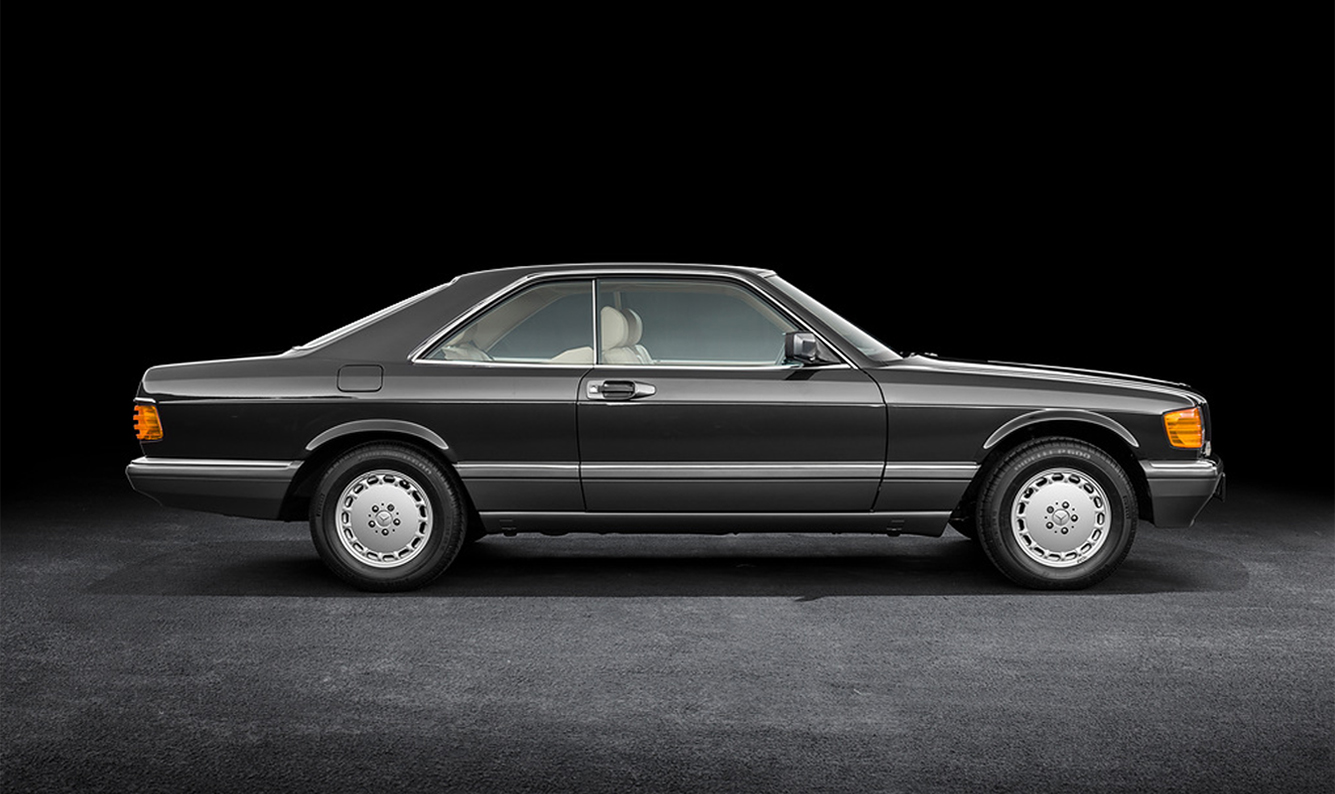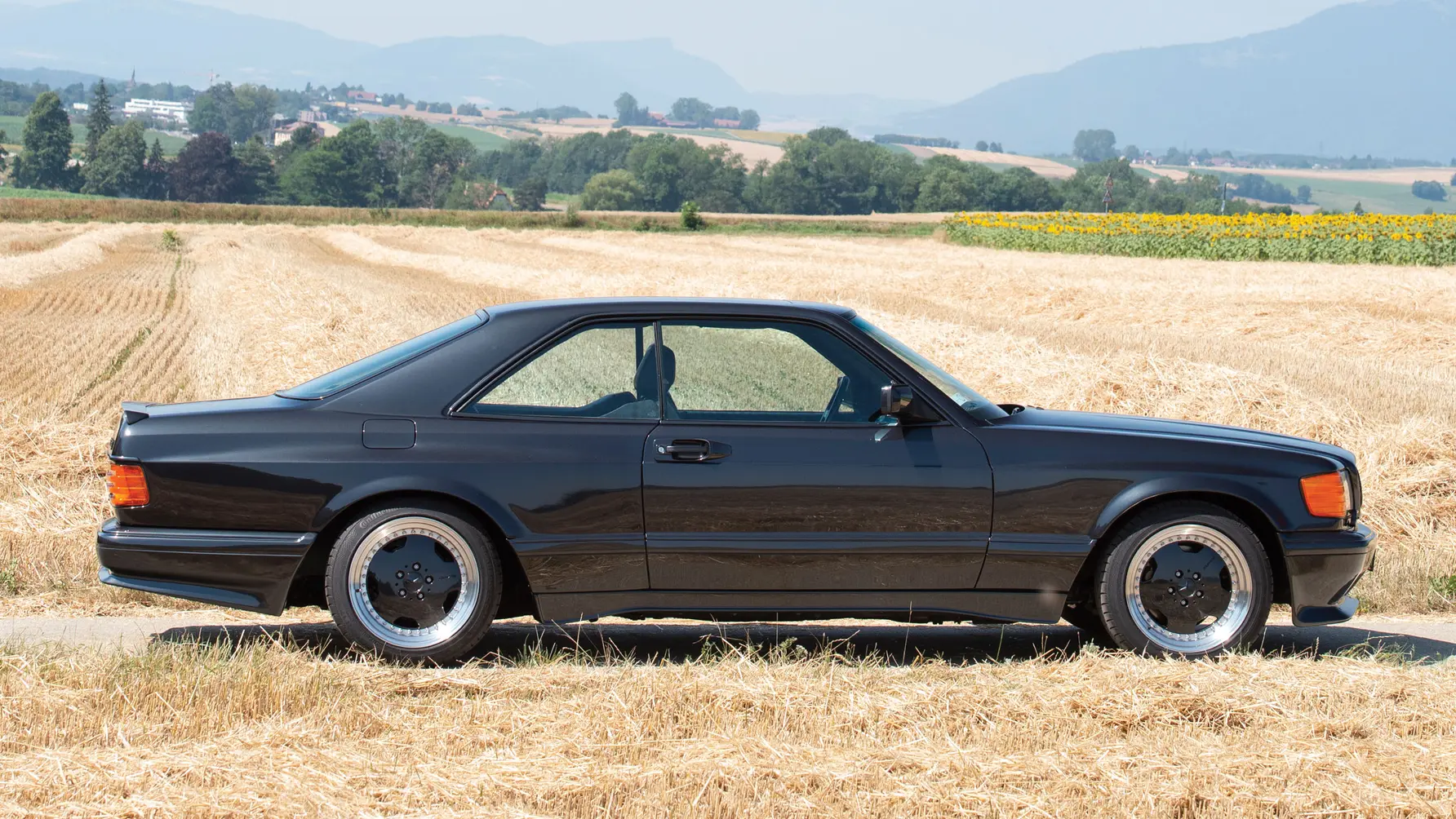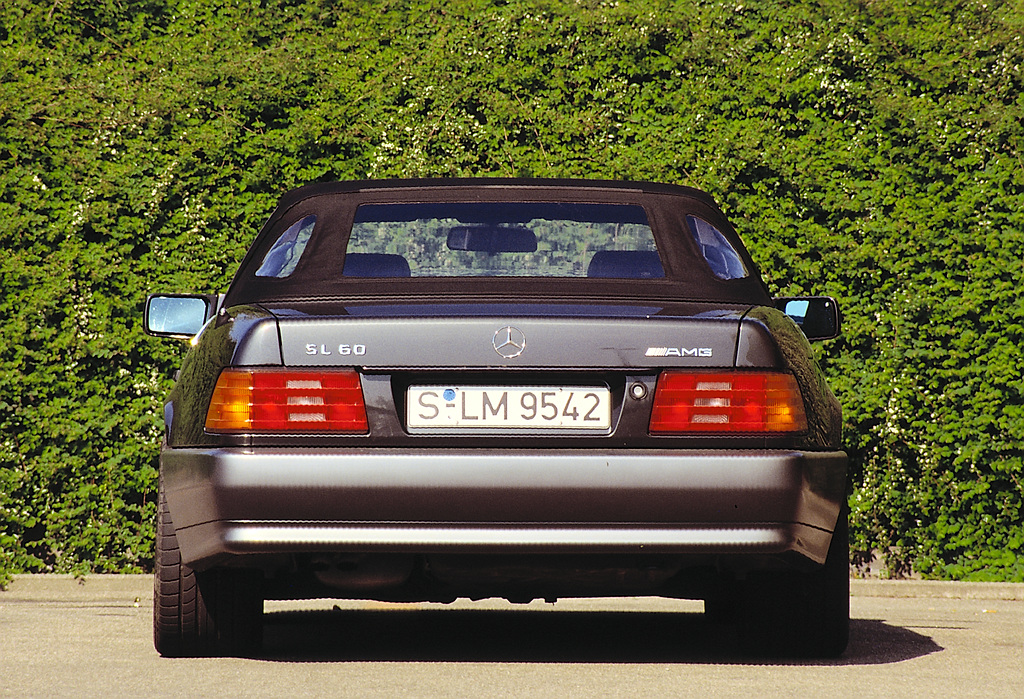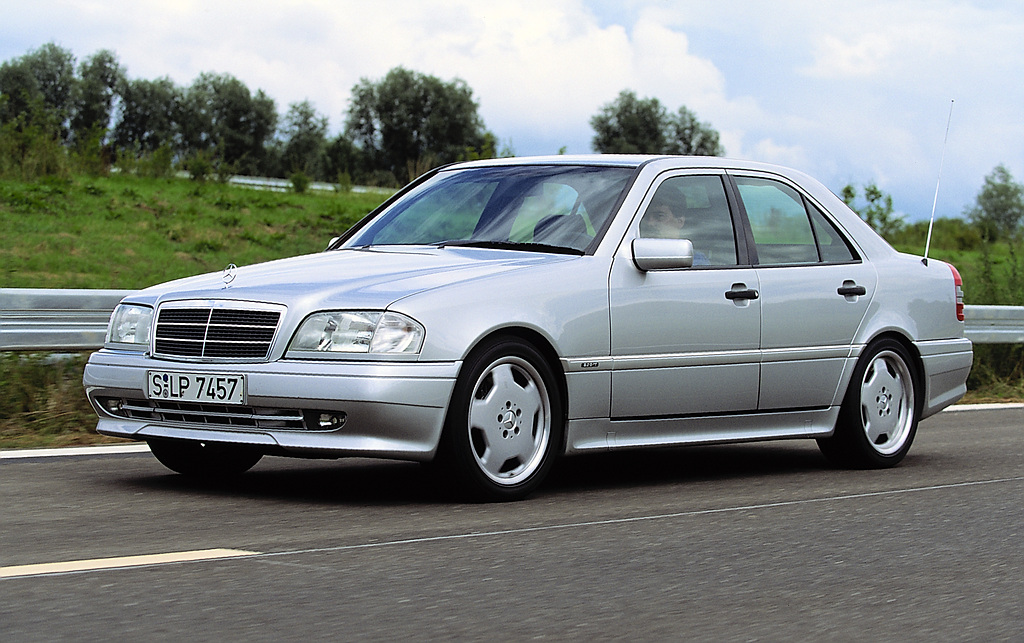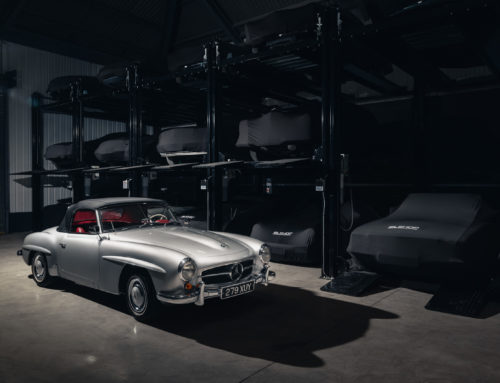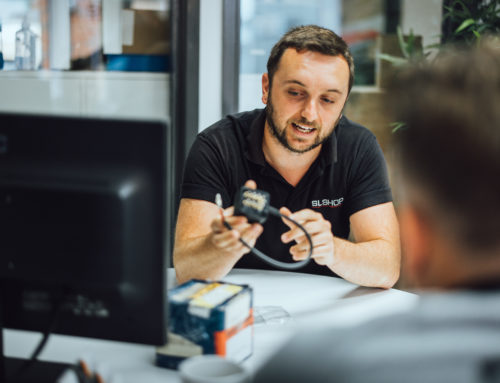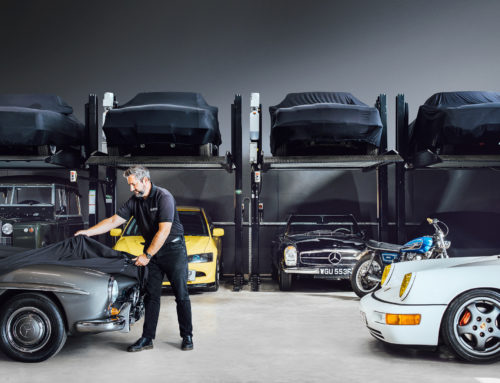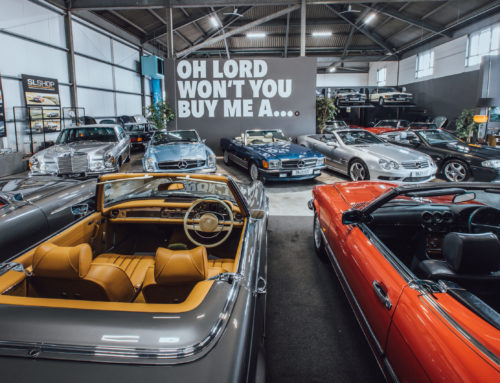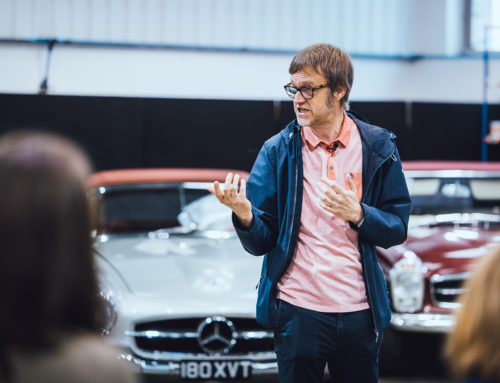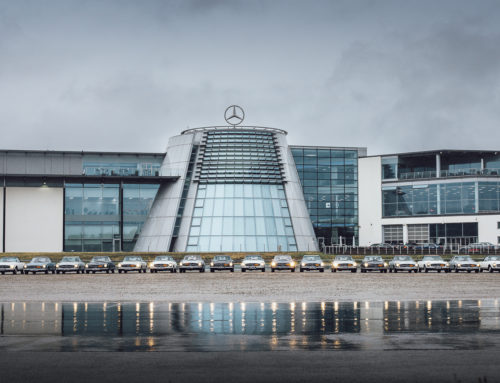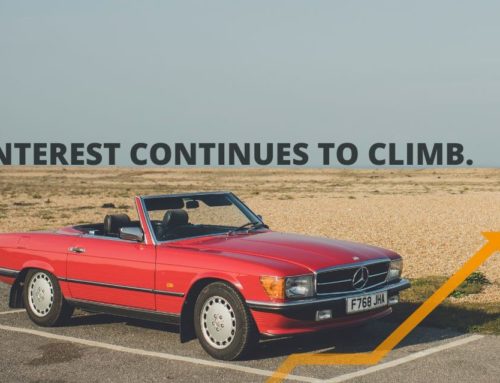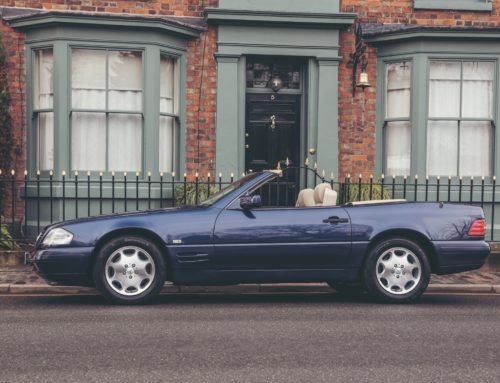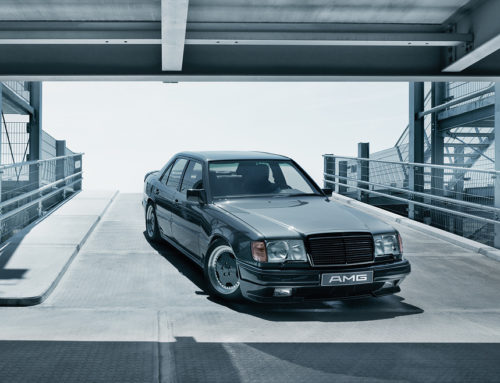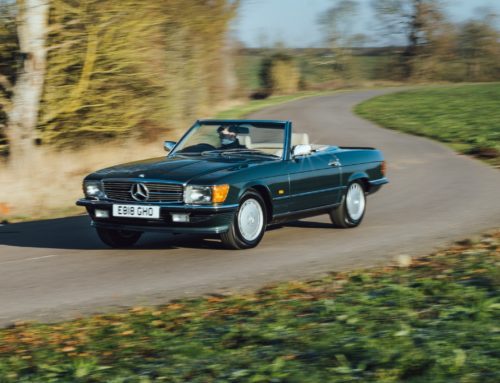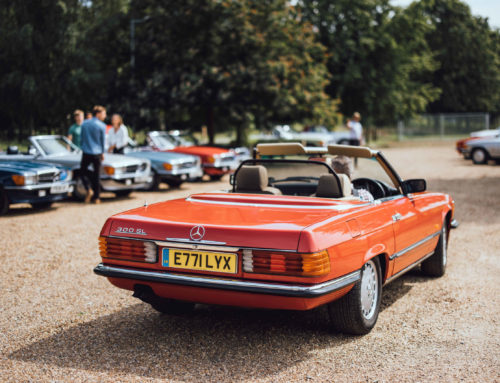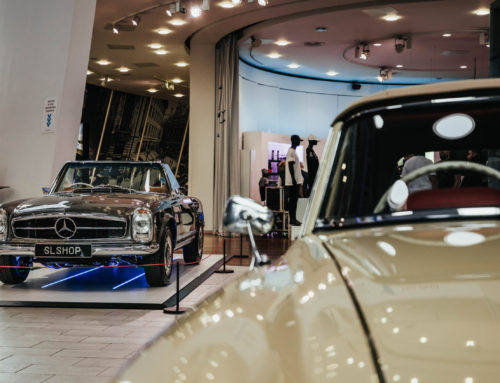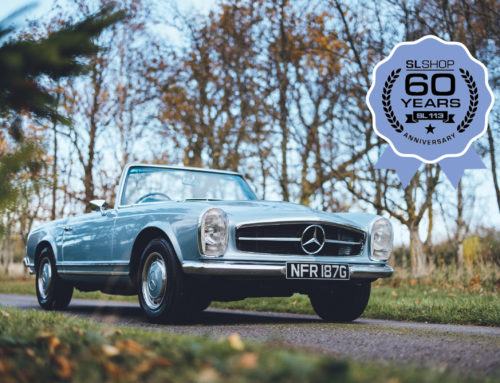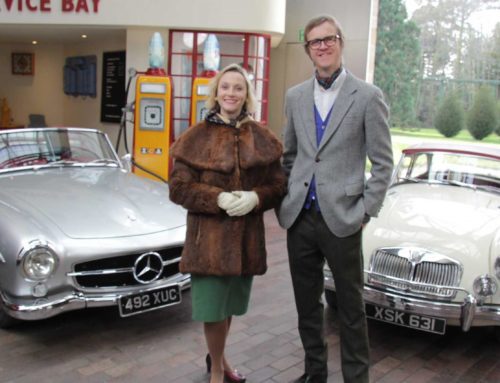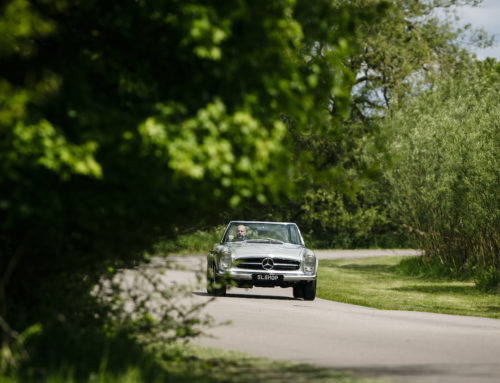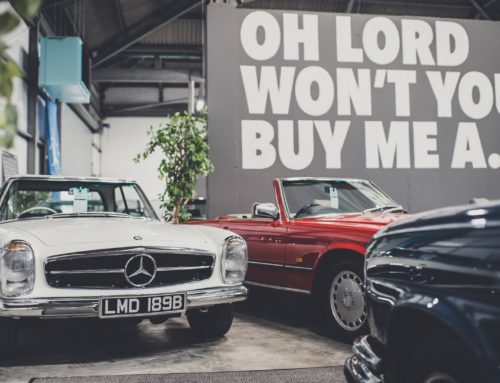From the imagination of two visionaries, a motorsport tour de force and major player in the 1980s Mercedes tuning scene emerged as a manufacturer in its own right. AMG’s rise to greatness has been as rapid as its products. Today it’s part of a global automotive empire that boasts quarterly profits in excess of $4.3 billion, yet it all launched 57 years ago on a considerably less fiscally-assured footing…
Two Mavericks, One Vision
Here in Britain we have a long and interesting engineering history. It’s not too much of a stretch to say that we were made great by individuals in sheds. Pioneers who didn’t accept the collected wisdom of the time, instead choosing their own paths – carving out a reputation on the back of their talent and tenacity. This legacy has contributed a near unimaginably vast amount to technical progress over the years, though it’s far from just being the preserve of natives to our shores. Our continental cousins – especially those in Germany – have been doing it for just as long, with arguably even greater success.
Two such mavericks, who turned a fledgling business in an old mill into one of the most recognisable and respected automotive firms on Earth, started off with little more than a few months wages and a dream. These two German engineers – whose initials have come to stand for engineering precision, motorsport dominance and near unmatched driver thrills – were Hans-Werner Aufrecht and Erhardt Melcher. The company they founded was, of course, AMG. Charting the early history of this firm makes for a fascinating tale, but that’s one for another day. Suffice it to say, that by the mid-1980s, AMG was poised for greatness, so that’s where we’re kicking things off.
“You can’t really improve a Mercedes… but you can make it different.”
Hans Werner Aufrecht

1980s Mercedes AMG Bespoke
If you wanted a bespoke and fast four-door saloon in the 1980s you weren’t really spoilt for choice. There was BMW’s new M5 but, if you were wealthy, that was probably deemed a little too common. If money was no object though, things got a lot more interesting and here, AMG was happy to help. In its pre-merger era, AMG took on almost any customer commission. If you had a Mercedes-Benz and wanted to up the excitement, Aufrecht and Melcher had you covered. Some truly wild creations emerged in this era, many of which cost eye-watering amounts of money, but it was the 1980s, so there was plenty of that flying about. Two of the most evocative conversions from this era of excess were 1980s Mercedes AMG’s wide body C126 and C124.
AMG had been subtly modifying customer cars since its inception, though it was more often concerned with performance and chassis tweaks. The 1980s saw the company grow in confidence, with the level to which it could tinker with your favourite Benz raising accordingly. Wide body conversions were only available for coupes but customers could have the go-faster mechanical goodies popped onto their four-doors and even estates. The immortal M5-crushing ‘Hammer’ was one such 1980s wonder, though the 1980s Mercedes coupe (C126) wide body was even more extreme…
- A standard 560SEC
- A ‘Wide Body’ 560SEC by AMG
Back in 1986, a Mercedes-Benz customer who had just bought a brand new 560 SEC for around £63k, could have it shipped to Afalterbach where it would spend the next two years being transformed into a wide-bodied weapon. If said customer ticked all the right AMG boxes, the already potent factory V8 was swapped for AMG’s own handbuilt quad-camshaft 385bhp 6.0-litre V8 – making twice the torque of the original M117 at half the rpm. The elegant pillarless bodylines of the C126 were given an extremely wide flaring front and rear. Adding some of the best looking electric Recaro seats ever fitted to a car and toys that would still put range-topping execs to shame today, resulted in a bill for more than £150k – that’s an astounding £460k today! A full-fat 1980s Mercedes AMG C126 had the comfort of a high-end limo yet could fend off all but the fastest of contemporary supercars. Little wonder then that less than 50 customers had pockets deep enough to actually order one.

The start of an enduring rivalry
By the end of the 1980s, with performance motoring booming, Mercedes-Benz was keen to keep relative upstarts BMW in its place. 1980s Mercedes AMG versions were increasingly being seen as natural rivals to M-power BMWs. This, together with the huge success AMG had achieved managing M-B’s racing activities (see timeline bellow), saw Daimler-Benz seek an even greater integration with AMG. The first flowering of this new move toward greater co-operation was the first AMG-tweaked model to be officially sold via Mercedes-Benz dealerships, with a full warranty.
That car was 1988’s Mercedes 190E 3.2 AMG. Around 200 fully-assembled cars were sold for a staggeringly expensive DM155,780. AMG continued to sell bolt-on upgrades for the ‘Baby Benz’ including body kits and its own 231bhp 3.2-litre straight-six engine. These go-faster bits allowed many more 190Es to receive the ‘AMG treatment’ – though without the factory warranty – with many simply sporting aero, rather than mechanical, upgrades. Nevertheless, 190Es with AMG tweaks were becoming a familiar sight and played a vital role in broadening the brand’s appeal.
- Mercedes-Benz SL 60 AMG of the R 129 model series. The model is the first AMG version to come from the direct cooperation of Mercedes-Benz and AMG. Photo from 1994.
Another big leap in AMG’s road to global dominance came with the launch of the Mercedes 1989 R129 SL. Sporting models have always naturally fallen more comfortably within AMG’s remit and the new SL was bursting with potential. It was the first generation of SL that AMG really got to tinker with right from the start. The models to emerge from its handiwork have since become legendary; SL60, 70, 72, 73 and SL55 all demonstrated what could really be achieved when Mercedes-Benz and AMG put their heads together. The first of these models to emerge was arguably the best of the lot. We only got 50 SL60s in right-hand drive but those few customers really were in for a treat…
The E500’s four-valve-per-cylinder M119 engine provided the shove – and a prodigious amount of it too. Reports vary, but it’s thought that AMG ignored M-B instruction to cap power at less than the SL600’s 389bhp. Chief bragging rights were supposed to remain with Stuttgart, but those cheeky scamps at Affalterbach weren’t content being bested in power stakes. Though officially seen to toe the line, the real power figure for the SL60 is thought to be north of 400bhp. This turned the R129 from a swift and stately GT into a slavering beast of a muscle car – though it was merely a taste of things to come.
There was no way that with the new M120 12-cylinder engine in the M-B parts catalogue, AMG was going to miss an opportunity to tinker. M-B might have wanted the SL600 to be the flagship, but it soon conceded there was little point having AMG straining at the leash – Affalterbach was given carte blanche to tinker in 1995 and boy did it go to town. The M120 V12 was a gift of an engine. Developed from two already potent M104 twin-cam six-cylinders, it was deliberately designed to best BMW’s recently introduced M70 V12. That Munich motor famously went on to power the McLaren F1 supercar – no pressure then…

Mercedes-Benz SL 60 AMG of the R 129 model series. The model is the first AMG version to come from the direct cooperation of Mercedes-Benz and AMG. Photo from 1994.
AMG’s version of the M120 had to be good and naturally, it was. The displacement was hiked first to 7.0- then 7.2- and eventually a mighty 7.3-litres. That final monumental displacement is still the largest V12 engine Mercedes-Benz/AMG has ever made. In this final 1999 incarnation it powered the uber rare SL73 AMG, an R129 with the pace to beat almost anything on the road. Power was up to 525bhp but the torque was even more impressive; 750nm (553 ft lb). Figures like this didn’t go unnoticed and just as BMW’s flagship 12-pot had caught McLaren’s eye, the M120 in AMG tune was favoured by super car start-up Pagani as the powerplant for its Zonda. Incidentally, this exotic Italian is three times more numerous than the 300 SL73s made worldwide.
- Mercedes-Benz C 36 AMG from model series 202, production period 1993 to 1997. Exterior, driving shot from front left. Photo from 1993.
- High-performance Mercedes-Benz C 36 AMG Saloon (1993). The first production vehicle to be developed jointly by Mercedes-Benz and AMG.
Mercedes AMG on the popular culture stage
Monumentally impressive as these 12-cylidnder SLs were, they weren’t going to attract the volume sales needed to really take the fight to BMW’s M-Power division. What was needed in this sphere was a small powerful and neat handling saloon to put Mercedes-Benz back in the mix with the M3 – the C36 was the result. The first official C-Class – replacing the 190E in June 1993 – the W202 had to play catch-up against its 3 Series E36 M3 rival launched a year earlier. A position that must have galled M-B, as its 2.3-16 190E had kicked off this compact performance grudge match in the first place back in 1983.
What we now associate with AMG saloons, massive power, epic noise and relaxed road manners – when you weren’t sideways – had yet to be established. The C36 was therefore a bit of an odd missing link between AMG the tuner and AMG a part of Mercedes-Benz proper. The C36 drove more like a contemporary fast 5 Series than either its predecessor 190E 3.2 AMG, or the M3. Ironic, as BMW’s 5 Series at the time was trying to emulate an old E-Class. Anyway, it didn’t matter one bit to Formula One management who made the C36 AMG the first official Mercedes-Benz/AMG safety car in 1996. With its automatic transmission and powerful six-cylinder engine, the C36 was a great BMW rival – it just wasn’t a rival to the right BMW (M3).
The W202-generation C-Class would also provide AMG with its first ‘in-house’, ground-up model in the form of the C36’s replacement; 1998’s C43 AMG. This was a distinct move in a more ‘AMG-ish’ direction. The C36 – based on the C280 Sport and visually near identical – was revised from the ground up. The C43’s base all-alloy 4.3-litre V8 engine came from the E430. AMG sprinkled its magic over this continental-only M113 motor, giving it magnesium intakes, forged conrods, double plugs and cast alloy pistons. The result was 302bhp and 60mph reached in 6.4 seconds. An even more potent version, tagged C55 AMG, was available later in production with 345bhp and the rear axle and transmission from the CLK55.
With its later V8 soundtrack, AMG badging and a recipe that paired understated looks with massive performance, the AMG C-Class was pivotal in refining AMG’s identity. The models that followed would further hone this, though that’ll have to wait for next time, as we chart AMG’s post-merger ascension to super stardom through some of the most exciting, flame-spitting creations the firm has produced to date.
1980s Mercedes AMG timeline
1965 – Hans-Werner Aufrecht (A) and business partner Erhardt Melcher (M) leave Mercedes-Benz to open up a new tuning firm. The pair buy an old mill in Burgstall and begin by squeezing all the power they can out of a customer’s 300SE engine.
1967 – With word spreading and demand increasing, AM gets its G on the end with a move to a more appropriate premises in Grossaspach – Aufrecht’s birthplace.
1971 – After their early success tuning customer 300s the pair buy a crash-damaged 300SEL from a local doctor and pour all their spare time and money into developing it into a racer. The ‘Red Pig’ as it’s christened goes on to take a shock class win at the 24-Hours of Spa, finishing second overall. Were it not for the car’s considerable thirst and weight (meaning more tyre changes) it would likely have won outright.
1976 – Its reputation as the world’s premier Mercedes-Benz tuner keeps the orders for production modifications rolling in and soon its combined racing and road efforts force another change of premises. This time, the move lasts, with AMG officially finding its forever home in Affalterbach.
1980 – An AMG prepared and campaigned 450SLC wins the ETCC (European Touring Car Championship) GP race at the Nürburgring.
1984 – Mercedes-Benz and AMG supply a suitably modified 1980s Mercedes E Class coupe to the F1 world championship to act as medical car – beginning the long association with F1 that still exists today. The same year AMG officially becomes an engine maker with its quad-cam 5.0-litre V8.
1986 – This new four-valve per cylinder engine provides the motive thrust for the AMG ‘Hammer’ possibly the best name in motoring. The 5.6-litre (later 6.0-litre) 360bhp Hammer became the world’s fastest production saloon with a top speed of 186mph (it was also available in C124 coupe configuration).
1986 – AMG’s monstrous 6.0-litre Widebody converted 560SEC becomes the darling of the world’s richest car collectors and is seen as the ultimate in 1980s tuning excess. The same year AMG’s racing activity in the 190E 2.3-16 is rewarded with a pair of wins in the DTM.
1988 – The first 1980s Mercedes AMG model to be sold officially through Mercedes-Benz dealerships is the 3.2-litre 190E AMG. AMG also records four more wins in the DTM with the 190E and Mercedes-Benz makes them its official racing partner.
1990 – A new co-operation deal is signed with M-B that allows AMG-tuned models to be sold and serviced through Mercedes-Benz global dealerships under factory warranty.
1991 – AMG records a historic manufacturer title in DTM with the 190E Evo II at the height of the championship’s popularity (reported to have a global audience of 153 million).
1993 – The 190 retires from the DTM championship with the introduction of the new C-Class. Its legacy was astonishing with the 190E taking 50 wins from the 1988-1993 seasons. German patent office registers the three iconic letters AMG as a trademark the same year.
1994 – C36 AMG debuts in the UK. A year later becoming the first AMG model to be officially sold in the USA.
1996 – C36 AMG becomes the first of many AMG-tuned safety cars in F1. In ’97 the CLK55 AMG takes over, then the CL55 in 2000 and the SL55 AMG a year later.
1997 – C43 AMG and E55 AMG broaden the appeal and cement the AMG saloon formula (big V8s, lots of drama but also refinement).
1998 – AMG becomes the first (and only) company to win all ten rounds of a world GT championship. The CLK GTR that decimated the competition was the first entirely AMG-designed and built model.
1999 – January 1st, Aufrecht sells his controlling shares in AMG to Daimler-Benz, who therefore now hold a majority. Mercedes-AMG is born.
2002 – Plan to crown each Mercedes-Benz model line with an AMG range topper is achieved with the SL55 (also the first AMG roadster sold in the US).
2003 – AMG plant in Affalterbach more than doubles its size to keep up with demand. The new facility now boasts 460k square foot of showrooms, development and engine facilities. This new plant allows for AMG’s now famous ‘one man, one engine’ philosophy to be rolled out. One of 45 master technicians build each car’s powerplant from scratch and adds his signature to the block upon completion.
2005 – Daimler-Chrysler (formerly Daimler-Benz) buys all remaining AMG stock, becoming its sole stockholder, creating Mercedes-AMG GmBH in the process.
SLSHOP is made up of 60 specialists dedicated to the AMG and Mercedes-Benz back catalogue. If you’d like support with your niche and exclusive AMG model, speak to our Workshop team today to discover our range of supporting services.

SLSHOP Workshops
Share With Your Fellow Enthusiasts
From the imagination of two visionaries, a motorsport tour de force and major player in the 1980s Mercedes tuning scene emerged as a manufacturer in its own right. AMG’s rise to greatness has been as rapid as its products. Today it’s part of a global automotive empire that boasts quarterly profits in excess of $4.3 billion, yet it all launched 57 years ago on a considerably less fiscally-assured footing…
Two Mavericks, One Vision
Here in Britain we have a long and interesting engineering history. It’s not too much of a stretch to say that we were made great by individuals in sheds. Pioneers who didn’t accept the collected wisdom of the time, instead choosing their own paths – carving out a reputation on the back of their talent and tenacity. This legacy has contributed a near unimaginably vast amount to technical progress over the years, though it’s far from just being the preserve of natives to our shores. Our continental cousins – especially those in Germany – have been doing it for just as long, with arguably even greater success.
Two such mavericks, who turned a fledgling business in an old mill into one of the most recognisable and respected automotive firms on Earth, started off with little more than a few months wages and a dream. These two German engineers – whose initials have come to stand for engineering precision, motorsport dominance and near unmatched driver thrills – were Hans-Werner Aufrecht and Erhardt Melcher. The company they founded was, of course, AMG. Charting the early history of this firm makes for a fascinating tale, but that’s one for another day. Suffice it to say, that by the mid-1980s, AMG was poised for greatness, so that’s where we’re kicking things off.
“You can’t really improve a Mercedes… but you can make it different.”
Hans Werner Aufrecht

1980s Mercedes AMG Bespoke
If you wanted a bespoke and fast four-door saloon in the 1980s you weren’t really spoilt for choice. There was BMW’s new M5 but, if you were wealthy, that was probably deemed a little too common. If money was no object though, things got a lot more interesting and here, AMG was happy to help. In its pre-merger era, AMG took on almost any customer commission. If you had a Mercedes-Benz and wanted to up the excitement, Aufrecht and Melcher had you covered. Some truly wild creations emerged in this era, many of which cost eye-watering amounts of money, but it was the 1980s, so there was plenty of that flying about. Two of the most evocative conversions from this era of excess were 1980s Mercedes AMG’s wide body C126 and C124.
AMG had been subtly modifying customer cars since its inception, though it was more often concerned with performance and chassis tweaks. The 1980s saw the company grow in confidence, with the level to which it could tinker with your favourite Benz raising accordingly. Wide body conversions were only available for coupes but customers could have the go-faster mechanical goodies popped onto their four-doors and even estates. The immortal M5-crushing ‘Hammer’ was one such 1980s wonder, though the 1980s Mercedes coupe (C126) wide body was even more extreme…
- A standard 560SEC
- A ‘Wide Body’ 560SEC by AMG
Back in 1986, a Mercedes-Benz customer who had just bought a brand new 560 SEC for around £63k, could have it shipped to Afalterbach where it would spend the next two years being transformed into a wide-bodied weapon. If said customer ticked all the right AMG boxes, the already potent factory V8 was swapped for AMG’s own handbuilt quad-camshaft 385bhp 6.0-litre V8 – making twice the torque of the original M117 at half the rpm. The elegant pillarless bodylines of the C126 were given an extremely wide flaring front and rear. Adding some of the best looking electric Recaro seats ever fitted to a car and toys that would still put range-topping execs to shame today, resulted in a bill for more than £150k – that’s an astounding £460k today! A full-fat 1980s Mercedes AMG C126 had the comfort of a high-end limo yet could fend off all but the fastest of contemporary supercars. Little wonder then that less than 50 customers had pockets deep enough to actually order one.

The start of an enduring rivalry
By the end of the 1980s, with performance motoring booming, Mercedes-Benz was keen to keep relative upstarts BMW in its place. 1980s Mercedes AMG versions were increasingly being seen as natural rivals to M-power BMWs. This, together with the huge success AMG had achieved managing M-B’s racing activities (see timeline bellow), saw Daimler-Benz seek an even greater integration with AMG. The first flowering of this new move toward greater co-operation was the first AMG-tweaked model to be officially sold via Mercedes-Benz dealerships, with a full warranty.
That car was 1988’s Mercedes 190E 3.2 AMG. Around 200 fully-assembled cars were sold for a staggeringly expensive DM155,780. AMG continued to sell bolt-on upgrades for the ‘Baby Benz’ including body kits and its own 231bhp 3.2-litre straight-six engine. These go-faster bits allowed many more 190Es to receive the ‘AMG treatment’ – though without the factory warranty – with many simply sporting aero, rather than mechanical, upgrades. Nevertheless, 190Es with AMG tweaks were becoming a familiar sight and played a vital role in broadening the brand’s appeal.
- Mercedes-Benz SL 60 AMG of the R 129 model series. The model is the first AMG version to come from the direct cooperation of Mercedes-Benz and AMG. Photo from 1994.
Another big leap in AMG’s road to global dominance came with the launch of the Mercedes 1989 R129 SL. Sporting models have always naturally fallen more comfortably within AMG’s remit and the new SL was bursting with potential. It was the first generation of SL that AMG really got to tinker with right from the start. The models to emerge from its handiwork have since become legendary; SL60, 70, 72, 73 and SL55 all demonstrated what could really be achieved when Mercedes-Benz and AMG put their heads together. The first of these models to emerge was arguably the best of the lot. We only got 50 SL60s in right-hand drive but those few customers really were in for a treat…
The E500’s four-valve-per-cylinder M119 engine provided the shove – and a prodigious amount of it too. Reports vary, but it’s thought that AMG ignored M-B instruction to cap power at less than the SL600’s 389bhp. Chief bragging rights were supposed to remain with Stuttgart, but those cheeky scamps at Affalterbach weren’t content being bested in power stakes. Though officially seen to toe the line, the real power figure for the SL60 is thought to be north of 400bhp. This turned the R129 from a swift and stately GT into a slavering beast of a muscle car – though it was merely a taste of things to come.
There was no way that with the new M120 12-cylinder engine in the M-B parts catalogue, AMG was going to miss an opportunity to tinker. M-B might have wanted the SL600 to be the flagship, but it soon conceded there was little point having AMG straining at the leash – Affalterbach was given carte blanche to tinker in 1995 and boy did it go to town. The M120 V12 was a gift of an engine. Developed from two already potent M104 twin-cam six-cylinders, it was deliberately designed to best BMW’s recently introduced M70 V12. That Munich motor famously went on to power the McLaren F1 supercar – no pressure then…

Mercedes-Benz SL 60 AMG of the R 129 model series. The model is the first AMG version to come from the direct cooperation of Mercedes-Benz and AMG. Photo from 1994.
AMG’s version of the M120 had to be good and naturally, it was. The displacement was hiked first to 7.0- then 7.2- and eventually a mighty 7.3-litres. That final monumental displacement is still the largest V12 engine Mercedes-Benz/AMG has ever made. In this final 1999 incarnation it powered the uber rare SL73 AMG, an R129 with the pace to beat almost anything on the road. Power was up to 525bhp but the torque was even more impressive; 750nm (553 ft lb). Figures like this didn’t go unnoticed and just as BMW’s flagship 12-pot had caught McLaren’s eye, the M120 in AMG tune was favoured by super car start-up Pagani as the powerplant for its Zonda. Incidentally, this exotic Italian is three times more numerous than the 300 SL73s made worldwide.
- Mercedes-Benz C 36 AMG from model series 202, production period 1993 to 1997. Exterior, driving shot from front left. Photo from 1993.
- High-performance Mercedes-Benz C 36 AMG Saloon (1993). The first production vehicle to be developed jointly by Mercedes-Benz and AMG.
Mercedes AMG on the popular culture stage
Monumentally impressive as these 12-cylidnder SLs were, they weren’t going to attract the volume sales needed to really take the fight to BMW’s M-Power division. What was needed in this sphere was a small powerful and neat handling saloon to put Mercedes-Benz back in the mix with the M3 – the C36 was the result. The first official C-Class – replacing the 190E in June 1993 – the W202 had to play catch-up against its 3 Series E36 M3 rival launched a year earlier. A position that must have galled M-B, as its 2.3-16 190E had kicked off this compact performance grudge match in the first place back in 1983.
What we now associate with AMG saloons, massive power, epic noise and relaxed road manners – when you weren’t sideways – had yet to be established. The C36 was therefore a bit of an odd missing link between AMG the tuner and AMG a part of Mercedes-Benz proper. The C36 drove more like a contemporary fast 5 Series than either its predecessor 190E 3.2 AMG, or the M3. Ironic, as BMW’s 5 Series at the time was trying to emulate an old E-Class. Anyway, it didn’t matter one bit to Formula One management who made the C36 AMG the first official Mercedes-Benz/AMG safety car in 1996. With its automatic transmission and powerful six-cylinder engine, the C36 was a great BMW rival – it just wasn’t a rival to the right BMW (M3).
The W202-generation C-Class would also provide AMG with its first ‘in-house’, ground-up model in the form of the C36’s replacement; 1998’s C43 AMG. This was a distinct move in a more ‘AMG-ish’ direction. The C36 – based on the C280 Sport and visually near identical – was revised from the ground up. The C43’s base all-alloy 4.3-litre V8 engine came from the E430. AMG sprinkled its magic over this continental-only M113 motor, giving it magnesium intakes, forged conrods, double plugs and cast alloy pistons. The result was 302bhp and 60mph reached in 6.4 seconds. An even more potent version, tagged C55 AMG, was available later in production with 345bhp and the rear axle and transmission from the CLK55.
With its later V8 soundtrack, AMG badging and a recipe that paired understated looks with massive performance, the AMG C-Class was pivotal in refining AMG’s identity. The models that followed would further hone this, though that’ll have to wait for next time, as we chart AMG’s post-merger ascension to super stardom through some of the most exciting, flame-spitting creations the firm has produced to date.
1980s Mercedes AMG timeline
1965 – Hans-Werner Aufrecht (A) and business partner Erhardt Melcher (M) leave Mercedes-Benz to open up a new tuning firm. The pair buy an old mill in Burgstall and begin by squeezing all the power they can out of a customer’s 300SE engine.
1967 – With word spreading and demand increasing, AM gets its G on the end with a move to a more appropriate premises in Grossaspach – Aufrecht’s birthplace.
1971 – After their early success tuning customer 300s the pair buy a crash-damaged 300SEL from a local doctor and pour all their spare time and money into developing it into a racer. The ‘Red Pig’ as it’s christened goes on to take a shock class win at the 24-Hours of Spa, finishing second overall. Were it not for the car’s considerable thirst and weight (meaning more tyre changes) it would likely have won outright.
1976 – Its reputation as the world’s premier Mercedes-Benz tuner keeps the orders for production modifications rolling in and soon its combined racing and road efforts force another change of premises. This time, the move lasts, with AMG officially finding its forever home in Affalterbach.
1980 – An AMG prepared and campaigned 450SLC wins the ETCC (European Touring Car Championship) GP race at the Nürburgring.
1984 – Mercedes-Benz and AMG supply a suitably modified 1980s Mercedes E Class coupe to the F1 world championship to act as medical car – beginning the long association with F1 that still exists today. The same year AMG officially becomes an engine maker with its quad-cam 5.0-litre V8.
1986 – This new four-valve per cylinder engine provides the motive thrust for the AMG ‘Hammer’ possibly the best name in motoring. The 5.6-litre (later 6.0-litre) 360bhp Hammer became the world’s fastest production saloon with a top speed of 186mph (it was also available in C124 coupe configuration).
1986 – AMG’s monstrous 6.0-litre Widebody converted 560SEC becomes the darling of the world’s richest car collectors and is seen as the ultimate in 1980s tuning excess. The same year AMG’s racing activity in the 190E 2.3-16 is rewarded with a pair of wins in the DTM.
1988 – The first 1980s Mercedes AMG model to be sold officially through Mercedes-Benz dealerships is the 3.2-litre 190E AMG. AMG also records four more wins in the DTM with the 190E and Mercedes-Benz makes them its official racing partner.
1990 – A new co-operation deal is signed with M-B that allows AMG-tuned models to be sold and serviced through Mercedes-Benz global dealerships under factory warranty.
1991 – AMG records a historic manufacturer title in DTM with the 190E Evo II at the height of the championship’s popularity (reported to have a global audience of 153 million).
1993 – The 190 retires from the DTM championship with the introduction of the new C-Class. Its legacy was astonishing with the 190E taking 50 wins from the 1988-1993 seasons. German patent office registers the three iconic letters AMG as a trademark the same year.
1994 – C36 AMG debuts in the UK. A year later becoming the first AMG model to be officially sold in the USA.
1996 – C36 AMG becomes the first of many AMG-tuned safety cars in F1. In ’97 the CLK55 AMG takes over, then the CL55 in 2000 and the SL55 AMG a year later.
1997 – C43 AMG and E55 AMG broaden the appeal and cement the AMG saloon formula (big V8s, lots of drama but also refinement).
1998 – AMG becomes the first (and only) company to win all ten rounds of a world GT championship. The CLK GTR that decimated the competition was the first entirely AMG-designed and built model.
1999 – January 1st, Aufrecht sells his controlling shares in AMG to Daimler-Benz, who therefore now hold a majority. Mercedes-AMG is born.
2002 – Plan to crown each Mercedes-Benz model line with an AMG range topper is achieved with the SL55 (also the first AMG roadster sold in the US).
2003 – AMG plant in Affalterbach more than doubles its size to keep up with demand. The new facility now boasts 460k square foot of showrooms, development and engine facilities. This new plant allows for AMG’s now famous ‘one man, one engine’ philosophy to be rolled out. One of 45 master technicians build each car’s powerplant from scratch and adds his signature to the block upon completion.
2005 – Daimler-Chrysler (formerly Daimler-Benz) buys all remaining AMG stock, becoming its sole stockholder, creating Mercedes-AMG GmBH in the process.
SLSHOP is made up of 60 specialists dedicated to the AMG and Mercedes-Benz back catalogue. If you’d like support with your niche and exclusive AMG model, speak to our Workshop team today to discover our range of supporting services.

SLSHOP Workshops
Share With Your Fellow Enthusiasts
More from Journal
CARE
THE ULTIMATE CERTIFIED SERVICING INVESTMENT PLAN
Your ownership journey matters to us, which is why we have created a simple certified servicing investment plan, tailored to your individual needs and aspirations.
Start investing today and our dedicated CARE team will work with you to increase the value and enjoyment you receive from your vehicle.

STAY IN TUNE WITH SLSHOP MOMENTS
As part of SLSHOP’s community of enthusiasts, you’ll be the first to hear about events and tours, key product offers, exciting stories from owners around the world and of course… our latest additions to the showroom. So, be the first to know and you might just sneak a car on your driveway or take your car’s condition to new heights with our exclusive replacement parts.
Or, visit SLSHOP Journal

